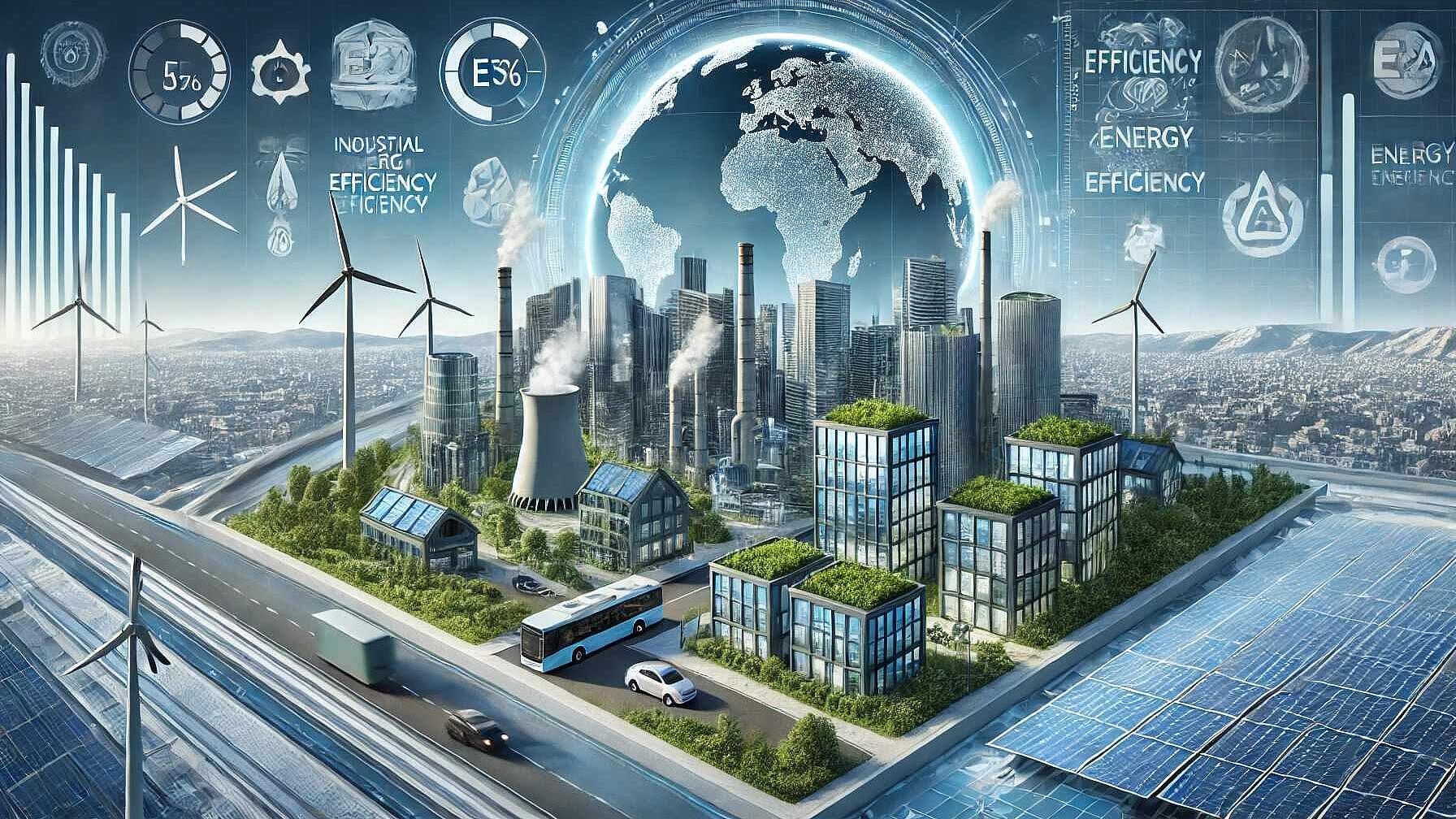 Energy Efficiency
Energy EfficiencyDoubling Energy Efficiency Progress: A Key to Achieving Climate Goals and Energy Security
Resumo
The IEA's "Energy Efficiency 2023" report underlines the imperative of doubling the rate of global energy efficiency improvement from the current 2% to 4% annually to achieve net-zero emission targets. Although there was a slight dip in global energy intensity improvement in 2023 to 1.3%, the EU and the US demonstrated significant improvements due to policy responses and behavioral shifts amid energy crises.
Doubling efficiency progress could significantly reduce energy bills, contribute to CO2 reduction targets, and generate jobs in various sectors. Governments are endorsing stronger policies towards this goal, with the intention to integrate it into upcoming COP28 discussions.
In transportation, electric vehicle sales are rising, which could substantially increase vehicle efficiency by 2030. The buildings sector is called to quadruple its efficiency improvement rate, with heat pump sales increasing and retrofits needing to double. Industry efficiency can be increased through digitalization and energy management systems, indicated by the growing adoption of ISO 50001.
The report notes nearly $700 billion in government support for energy efficiency since 2020, with substantial investments from new initiatives. However, challenges like outdated building energy codes and slow stock turnover can hinder progress. Achieving the 4% annual improvement requires consistent policy and investment.
Efficiency standards for key products in many countries align with net-zero goals, and global adoption of best practices is vital. Systems efficiency is increasingly relevant due to electrification and renewable energy integration, with digital technologies supporting advanced energy management.
The IEA cites South Australia's adaptation to high renewable energy penetration through smart systems to reduce energy costs. Efficient cooling technology adoption is crucial for managing rising cooling demands in countries like India.
The report concludes that the energy efficiency goal, while daunting, is achievable with the necessary focus on technology, policy, and implementation. This improvement is seen as key to meeting energy security, affordability, job creation, and climate objectives.
Artigo aberto completo
Doubling Energy Efficiency Progress: A Key to Achieving Climate Goals and Energy Security
As the world grapples with intersecting energy, climate and cost of living crises, energy efficiency has emerged as a crucial solution that can simultaneously address all three challenges. The International Energy Agency's (IEA) latest Energy Efficiency 2023 report highlights the urgent need to double the rate of global energy efficiency progress this decade, from around 2% annually to 4%, to keep net zero emissions targets within reach.
While 2023 saw a slight slowdown in global energy intensity improvement to 1.3%, down from 2% in 2022, this masks significant gains in some regions. The European Union and United States registered robust improvements of 5% and 4% respectively, driven by strong policy action and consumer behavior changes in response to the energy crisis. However, China's economic rebound and industrial growth offset these gains at the global level.
The IEA report emphasizes that doubling efficiency progress could cut energy bills in advanced economies by one-third and make up 50% of CO2 reductions needed by 2030. It would also create 4.5 million more jobs than today across manufacturing, building renovation, construction and transport sectors.
Encouragingly, momentum is building around this global target. At the IEA's 8th Annual Global Conference on Energy Efficiency in Versailles, 46 governments endorsed a statement supporting stronger policies towards doubling efficiency progress this decade. The target has also gained traction in G20 and G7 forums, with plans to formalize it at COP28 alongside renewable energy goals.
Achieving this ambitious target will require a profound transformation across all sectors. In transport, electric vehicle sales are surging, reaching around 18% of global car sales in 2023. This is driving a radical lift in passenger vehicle efficiency, with the average annual improvement rate expected to more than triple from 1.6% to 5% by 2030 in the IEA's Net Zero Scenario.
The buildings sector faces an even steeper challenge, needing to quadruple its efficiency improvement rate from 1.2% to over 5% annually. This entails more than doubling the current global retrofit rate to 2.5% of existing buildings per year by 2030. Heat pumps are playing a central role, with global sales rising 11% in 2022 amid high gas prices and increased policy support.
In industry, digitalisation and advanced energy management systems are key to unlocking further efficiency gains. The number of industrial facilities certified to the ISO 50001 energy management standard grew by almost 30% in 2022, indicating rising corporate action on efficiency.
Policies and investments are accelerating to drive this efficiency revolution. Since 2020, governments have spent almost $700 billion to support energy efficiency investments. New programs like the US Inflation Reduction Act and EU's REPowerEU plan are dedicating unprecedented resources to efficiency. Property Assessed Clean Energy (PACE) financing is also expanding rapidly, having funded over $13.6 billion in building upgrades.
However, the report notes implementation challenges remain. While many countries have strengthened efficiency regulations, around one-third of building energy codes globally have not been updated since 2015. Slow stock turnover in buildings and industry means it can take years or decades for new standards to significantly impact energy demand.
The IEA emphasizes that doubling efficiency progress is challenging but achievable. Over 90% of countries have achieved a 4% annual improvement at least once in the past decade, though sustaining this consistently will require greater policy ambition and investment.
Crucially, the technologies and policies needed already exist in most sectors. Many countries have efficiency standards for key products like lighting and motors that meet or exceed levels consistent with net zero pathways. Expanding and strengthening these best practices globally could go a long way towards achieving the doubling target.
Beyond traditional efficiency measures, the report highlights the growing importance of "systems efficiency" approaches as electrification and renewable deployment accelerate. Digital technologies are enabling more sophisticated energy management in buildings and industry, while demand response programs are helping balance increasingly variable electricity supply and demand.
The IEA provides the example of South Australia, where high renewable penetration has dramatically changed electricity demand and price patterns. Consumers and businesses are adapting with solar, batteries and smart energy management systems to take advantage of periods of negative wholesale prices, significantly reducing energy costs.
Such system-level efficiency gains will be critical to manage rising cooling demand, especially in rapidly growing markets like India. The report notes that every 1°C increase in average daily temperature above 24°C drives a 2% rise in India's electricity demand. Efficient cooling technologies and strategies like district cooling systems will be essential to provide thermal comfort while limiting strain on power grids.
In conclusion, while the energy efficiency challenge is immense, it also presents a major opportunity. By redoubling efforts this decade to improve efficiency across all sectors, countries can enhance energy security, reduce consumer costs, create jobs, and get on track to meet climate goals. With the technologies and policy tools already available, achieving this target is primarily a matter of ambition and implementation. As the world looks towards COP29 and beyond, accelerating energy efficiency progress must be at the heart of climate and energy strategies.
Source: https://www.iea.org/reports/energy-efficiency-2023



